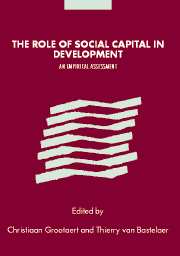Book contents
- Frontmatter
- Contents
- List of figures and maps
- List of tables
- List of boxes
- Notes on contributors
- Acknowledgments
- Foreword by Robert D. Putnam
- Introduction and overview
- Part 1 Social capital at the micro and macro levels: a conceptual discussion and review
- Part 2 The impact of social capital on development
- Part 3 The creation and transformation of social capital
- 7 The impact of development assistance on social capital: evidence from Kenya
- 8 Induced social capital and federations of the rural poor in the Andes
- 9 Social capital and social cohesion: case studies from Cambodia and Rwanda
- 10 Ethnicity, capital formation, and conflict: evidence from Africa
- Conclusion: measuring impact and drawing policy implications
- Index
- References
9 - Social capital and social cohesion: case studies from Cambodia and Rwanda
Published online by Cambridge University Press: 22 September 2009
- Frontmatter
- Contents
- List of figures and maps
- List of tables
- List of boxes
- Notes on contributors
- Acknowledgments
- Foreword by Robert D. Putnam
- Introduction and overview
- Part 1 Social capital at the micro and macro levels: a conceptual discussion and review
- Part 2 The impact of social capital on development
- Part 3 The creation and transformation of social capital
- 7 The impact of development assistance on social capital: evidence from Kenya
- 8 Induced social capital and federations of the rural poor in the Andes
- 9 Social capital and social cohesion: case studies from Cambodia and Rwanda
- 10 Ethnicity, capital formation, and conflict: evidence from Africa
- Conclusion: measuring impact and drawing policy implications
- Index
- References
Summary
The Cold War, in which superpowers sought to maintain a global balance of power without resorting to nuclear arms, masked many local, intrastate conflicts by internationalizing them. What were really civil wars among indigenous peoples contending for local power were turned into “virtual” international conflicts fought by proxy. Externally financed economic growth and outside support for authoritarian regimes concealed deeply rooted internal ethnic, religious, social, and economic cleavages. With the end of the Cold War, this virtual bubble burst: of the ninety-six violent conflicts that occurred between 1989 and 1995, ninety-one are considered civil conflicts (Wallensteen and Sollenberg 1996).
Unlike interstate conflict, which often mobilizes national unity and strengthens national social cohesion, violent conflict within a state weakens its social fabric. Intrastate conflict divides the population, undermines interpersonal and communal group trust, and destroys norms and values that underlie cooperation and collective action for the common good, decimating social capital stocks – and, thus, exacerbating communal strife. This damage to a nation's social fabric impedes the ability of states and communities to recover after hostilities cease. Even if other forms of capital are replenished, economic and social development will be hampered unless social capital stocks are restored. Ideally, this restoration of social capital will support bonds within communities, build bridges between communities, and link state and community levels, hence strengthening the society's cohesiveness.
- Type
- Chapter
- Information
- The Role of Social Capital in DevelopmentAn Empirical Assessment, pp. 279 - 309Publisher: Cambridge University PressPrint publication year: 2002
References
- 4
- Cited by



